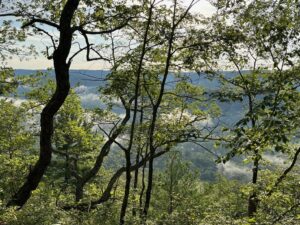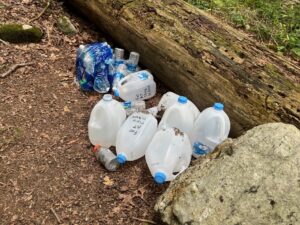All Is Well on the Appalachian Trail — Or Is It?
 A view from the Appalachian Trail (photo by Tom Krattenmaker)
A view from the Appalachian Trail (photo by Tom Krattenmaker) Reassurance awaited me at every turn during my recent three-day backpacking trip on the Appalachian Trail.
The ancient forest dazzled on the stretch of trail I covered along the Connecticut-New York border. The sun-dappled, luxuriant green exuded a sense of health and flourishing. Vistas beckoned to the east and west. My alarmingly close encounter with a rattlesnake—they’re rare but still present in this part of the country—woke me up to the enduring wildness of the place. (As if I needed reminding; I’d seen a bear and cub during a day hike not far from the rattlesnake spot three weeks before.)
The weather was northeast summertime at its finest, temperatures peaking at a manageable eighty degrees in the afternoon and cooling to the high fifties overnight.
All was well, climate change or not. Or was it?
The thru hikers I talked with on the trail and at the tent sites had a different story to tell. I, of course, had been watching the forecast from New Haven for weeks, swooping in when I saw favorable weather arriving. But these long-haul walkers on their way from Georgia to the AT terminus in Maine had been trudging through unrelenting heat and humidity, as if fifteen miles a day on steep, rocky terrain under thirty-pound backpacks wasn’t enough of a trial already.

Jugs of water help stave off dehydration on the Appalachian Trail (photo by Tom Krattenmaker)
To help the hikers stave off dehydration, “trail angels,” as they’re called, had set out out jugs and bottles of water in the places where the trail crosses roads, scrawling “For AT thru hikers” on the plastic.
The long-haulers had hiked through a powerful thunderstorm the day before I started my quick visit to their world. One hiker told me she’d welcomed the downpour and walked right through it, unfazed by the storm’s potential violence and relishing the cool water that poured down on her. Another hiker told me he, too, had kept walking when the storm hit. He enjoyed the theater of it, he said, the crackling of the lightning and thunder all around him. “It’s all part of the experience,” he explained.
That experience is gradually becoming less viable. Increasingly, downpours bring more than cooling relief. They can flood the streams that the AT crosses, making them dangerous if not impossible to ford. They can wash out portions of the trail and saturate the ground so much that treefalls become a threat. As temperatures rise, heat stroke becomes more of a danger on the trail, despite the trail angels’ worthy efforts.
At what point must even the bravest, fittest thru hikers say “enough”?
That’s already happening on the Pacific Crest Trail. Made famous by the book and movie Wild, the PCT, while challenging before, is damn near impossible to thru-hike now.
“On the Pacific Crest Trail, the chances of finishing a thru-hike where you walk a continuous footpath from Mexico to Canada is looking more impossible to complete every year, due to fires closing portions of the trail,” one serial PCT hiker testifies. “Hikers are left having to skip and hitchhike around portions of trail.” He says, “There are water sources listed in maps/guides that you may not be able to count on if there wasn’t enough snow over the winter.”
Such reports grieve me. Not that I have any bucket-list dreams of thru-hiking the PCT or AT. A few days at a time are enough for me. It’s the thought of degradation in our beautiful wild places that causes sadness and alarm. To immerse in the woods once or twice a year is a tremendous amount of fun for me, but it’s more than that. It’s restorative. It shifts my perspective. It reminds of what, and where, the organic real world is.
Even if you’re one of the many people who think backpackers are crazy and who want no part of forest life, with the bugs and dirt and freeze-dried food and sleeping on a thin mat on hard ground, you know that the thru hikers are canaries in the coalmine. You understand that the larger forces straining the trail are coming to your door, too, if they have not already.
I do recommend the backpacking experience to all who have the mobility and access and can tolerate a few days without showers and toilets. The mountains and forests and streams are for me what a beautiful house of worship is for a religious person. Many other humanists and otherwise secular people say the same. The pristine natural places are much more than “nice” and “pretty, although they are definitely that. They’re profound.
Thoughts happy and ominous stream through a humanist’s mind backpacking on the Appalachian Trail this summer. You behold so much that’s still there and still great. You know it’s changing, not in a good way, in step with the planet’s climate. There’s so much to love, so much to lose.
